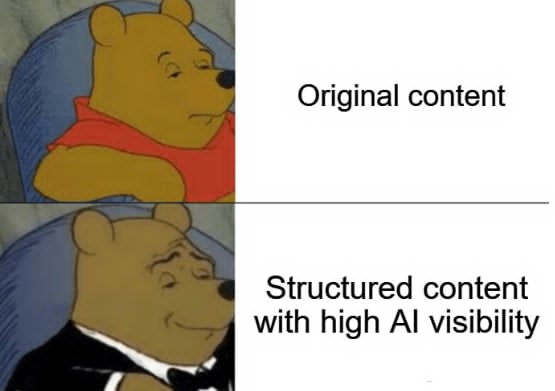Structured Content: The Real Language of Generative Engine Optimization

Generative engines like ChatGPT, Claude, and Gemini don’t read your website like Google; they interpret it. Your visibility no longer depends on keyword density or backlinks but on how well your structure helps AI understand meaning. Without structured content, you’re not invisible because of competition, you’re invisible because AI can’t make sense of you.
Why Structure Content Is the Foundation of Generative Engine Optimization
The biggest shift from SEO to Generative Engine Optimization is this: Google measures what people click, while AI measures what content makes sense. Google’s crawler can index broken or repetitive content because it reads syntax like links, tags, and anchor text.
But generative engines read semantics such as logical order, factual alignment, and entity relationships. When your content lacks structure, AI cannot assign reasoning value to it. That’s why most “optimized” pages vanish from ChatGPT results.

Structure is how AI learns what matters
In the world of Generative Engine Optimization (GEO), structure acts like grammar for AI comprehension. It tells models what is a definition, what’s context, and what’s evidence. Without it, even great writing becomes meaningless.
Take HubSpot’s content strategy as an example. Every HubSpot article follows the same mental model:
- It defines the concept clearly.
- It explains why the concept matters.
- It provides frameworks and data points.
- It ends with a practical example or call to action.
This consistent flow allows AI to identify logical anchors, meaning HubSpot’s content trains models to associate the brand with authority in CRM, marketing automation, and inbound strategy. Even when HubSpot isn’t directly cited, ChatGPT still rephrases its reasoning patterns in its answers.
That’s not luck. That’s structure.
How structure becomes the foundation of trust
Many SaaS blogs produce what looks like helpful content, such as “10 Best AI Tools” or “Top SEO Tips.” These are flat articles with weak internal logic, no hierarchy, no semantic flow, and just keyword repetition.
To humans, they seem fine. To AI, they’re contextless. There’s no cause-and-effect relationship between statements, so the model can’t reason with it.
In Generative Engine Optimization terms, that content has low Reasoning Depth Ratio (RDR) and low Visibility Depth Index (VDI). It’s visible to crawlers but not interpretable to models. Structured content isn’t just neat formatting; it’s what makes your ideas machine-readable and memory-stable.
How Generative Engines Interpret Structured Content
When a human reads a page, they follow the narrative from top to bottom. When AI reads, it builds a semantic reasoning tree, a network of relationships that links definitions, evidence, and implications. That reasoning tree helps AI decide whether your content is worth recalling.
What AI actually does with your content
Every sentence gets categorized into reasoning roles:
- Definition: what is this about
- Context: why does it matter
- Evidence: what supports this claim
- Resolution: what is the conclusion or takeaway
Pages that follow a consistent reasoning structure make it easier for AI to infer relationships between ideas. It knows that paragraph two explains paragraph one, not just repeats it. That’s why structure determines not just readability but AI recall frequency, how often your brand appears in model-generated answers.
Case: Shopify vs BigCommerce
A 2025 GEOReport.ai audit found that Shopify’s educational pages about “Ecommerce SEO” were cited by ChatGPT and Claude 3.4 times more often than BigCommerce’s. Both rank similarly on Google, but Shopify’s structure follows logical clarity with definitions, importance, frameworks, examples, and conclusion.
BigCommerce’s pages, though rich in text, often mix product promotion with explanation, confusing AI’s reasoning tree. Shopify’s content wasn’t longer; it was logically cleaner, so the model could reuse it confidently. That’s how structured writing translates into reasoning visibility.
The structure-memory connection
When AI models like GPT-4 ingest content, they don’t copy it. They abstract reasoning patterns from it. Structured pages therefore train AI to recognize your brand’s logic. Unstructured pages don’t make it into long-term embeddings; their reasoning weight decays faster.
That’s why your visibility in generative engines can drop over time, even without new competitors. A well-structured page increases Entity Confidence Stability (ECS), which represents AI’s internal confidence that your brand is reliable and consistent. Once that ECS stabilizes, you become a default reasoning source across multiple AI systems.
Why Unstructured Content Fails (Even When SEO Says You’re Winning)
It’s easy to think your content is working when your SEO dashboard looks green. Traffic is steady, rankings are high, backlinks are growing. But SEO tools don’t measure reasoning visibility, and that’s where most brands fail in the AI era.
Google measures popularity. AI measures understanding.
Google rewards content that is loud. AI rewards content that is clear.
| Google SEO | Generative Engine Optimization |
|---|---|
| Focus: Indexing and ranking | Focus: Interpretation and recall |
| Values: Keywords, backlinks, dwell time | Values: Logic, factual stability, entity clarity |
| Goal: Get clicks | Goal: Be used in reasoning |
This explains why your SEO report can look perfect, yet ChatGPT never mentions you.
Example: Canva vs Figma
Both dominate visual design SEO keywords. But when GEOReport.ai ran a reasoning audit across ChatGPT, Gemini, and Perplexity, Canva appeared in 68% of design-related reasoning chains; Figma appeared in only 37%.
Canva’s content consistently follows a structured format:
- Concept (Design education)
- Context (Why templates matter)
- Evidence (User metrics, product examples)
- Outcome (Empowerment through simplicity)
Figma’s educational content is beautifully written but visually fragmented with great UX but poor logic consistency. So while users love it, AI models can’t easily extract reasoning from it. The result is that Canva dominates in AI-driven brand recall.
Redundancy: when SEO success becomes AI noise
Traditional SEO teaches you to repeat key phrases. In Generative Engine Optimization, that’s a penalty. If you publish five articles saying nearly the same thing, AI merges them into one reasoning node and ignores the rest. You think you have a content hub; AI thinks you have an echo chamber.
Factual instability: the silent visibility killer
AI cross-references facts between your pages. If your “About” page says your company was founded in 2017 but your press kit says 2018, your factual trust score drops. Even if your content is well-written, your brand becomes statistically unreliable.
In 2025, GEOReport.ai tested this by auditing SaaS companies with inconsistent schema data. One small detail like a mismatched founding date or product description lowered Entity Confidence Stability (ECS) by 20–30%. That’s like losing domain authority overnight but in AI memory, not Google ranking.
How to Create Structured Content That AI Can Reason With
If SEO taught marketers to write for crawlers, Generative Engine Optimization teaches them to write for cognition. You’re not optimizing for clicks anymore; you’re optimizing for understanding.

Step 1: Think in reasoning flows, not keywords
The biggest mental shift for marketers is to stop thinking in keyword clusters and start thinking in idea clusters. Ask: “How would AI explain this logically?”
Structure your content like a reasoning map: concept → why it matters → how it works → evidence → conclusion.
Notion’s “AI Workspace” documentation does this brilliantly. Instead of listing features, it builds understanding through cause-effect reasoning. That’s why Notion often gets cited by ChatGPT as an example of “AI productivity,” even in unrelated contexts.
Step 2: Use schema as meaning markers
Schema markup helps AI tag sections by purpose, such as this is a question, this is a definition, this is an example. Without it, your content has no landmarks in the reasoning tree.
Most marketers stop at basic Article schema. But advanced structured content uses combinations like:
- FAQ + HowTo for educational content
- Product + Review for commerce
- Article + Organization for authority
Shopify’s developer hub uses detailed schema that connects documentation, tutorials, and community discussions. That’s why it ranks high in GEOReport’s Schema Integrity Score (SIS) and appears frequently in Gemini-generated API references.
Step 3: Maintain factual and structural consistency
Every inconsistency is a lost trust signal. AI values precision more than volume. Centralize facts in one canonical file and synchronize data across all pages.
Brands like Intercom and Airtable do this exceptionally well. Every product description, tagline, and number is identical across docs, blogs, and press pages. That precision creates structural coherence, and AI knows these pages belong to one consistent entity.
Step 4: Write for reasoning readability
Generative models understand logic through transitions. Phrases like because, as a result, for example, in contrast, and this means act as connectors for reasoning flow. They tell AI where ideas lead.
Compare: “AI SEO tools help businesses grow.” vs “AI SEO tools help businesses grow because they transform optimization from reactive keyword chasing into predictive reasoning.” The second version teaches why, and that’s what AI retains.
Step 5: Audit like AI with GEOReport.ai
Finally, validate your structure using tools that read like generative models do. GEOReport.ai’s Site Audit evaluates four key Generative Engine Optimization benchmarks:
- Layout Structure: checks hierarchy clarity
- Readability Flow: detects reasoning patterns
- Schema Integrity: validates structured data
- Credibility & Consistency: measures factual trust
You’ll see how ChatGPT, Gemini, and Claude interpret your pages and where your reasoning chain breaks. That’s how you move from optimized to understood.
FAQs
Q1. Why is structured content so important for Generative Engine Optimization?
A1. Because AI models like ChatGPT and Gemini rely on reasoning, not keywords. Structured content helps them identify logic, context, and evidence, which makes your brand easier to interpret and recall.
Q2. How does structure improve AI visibility compared to SEO ranking?
A1. SEO focuses on ranking signals like backlinks and keywords, while Generative Engine Optimization measures reasoning quality. Structure makes your content understandable to AI, which boosts reasoning inclusion even if rankings stay the same.
Q3. Can I just use schema markup to fix my structure?
A3. Schema helps, but it’s not enough alone. You need logical flow, factual consistency, and clarity in writing to support the schema so AI can interpret meaning accurately.
Q4. What happens if my content is well-written but unstructured?
A4. It may perform well on Google but remain invisible in AI results. Without structure, AI can’t connect your ideas into a reasoning chain, so your brand gets excluded from generative answers.
Q5. How can GEOReport.ai help improve structured content?
A5. GEOReport.ai audits your layout, schema, readability, and factual consistency to reveal where your structure breaks. It provides clear, prioritized actions to make your content AI-interpretable and Generative Engine Optimization-optimized.
Editor's note
Structured content is not decoration; it’s cognition design. It’s how you teach AI what your brand means, not just what you sell. If SEO made you discoverable, structure makes you memorable. It turns words into logic, pages into reasoning maps, and brands into knowledge sources.
The internet used to reward attention. Now, it rewards clarity. And clarity starts with structure. Run a GEOReport.ai Site Audit today to see what your content looks like through AI’s eyes, because in the generative web, only structured content survives reasoning decay.
